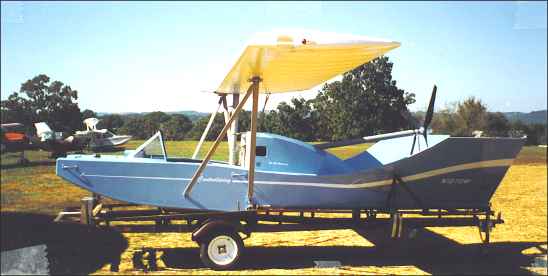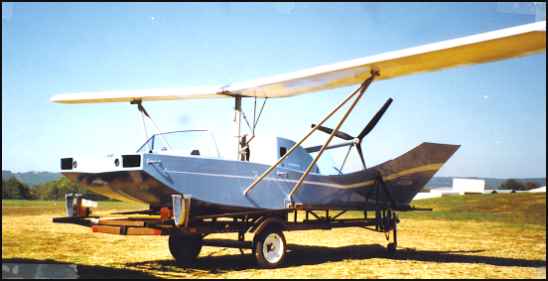
by George Wolfe Current Activity |
 |
"My first Spratt Controlwing Flying Boat" Collection of George Wolfe, 8-21-07 |
|
My Controlwing flying boat N107GW was built using George G. Spratt's 1973 plans with many
personal changes incorporated and marked on the plans. I used an 85 HP Mercury marine outboard powerhead, modified per Spratt's
instructions. Wooden construction was used throughout, not the all composite construction of the early prototype N910Z which
weighed about 500 lbs. Mine and one of two other known all wood plans-built aircraft flown weighed about 250 pounds more.
My aircraft may be seen in the September and October 1998 Sport Aviation magazines, the April 2000 Experimenter, EAA’s
Aerocrafter plans book and the web site www.georgespratt.org I offer a Controlwing flying boat plans package including 33 of Spratt's drawings, 80 pages of construction and general miscellaneous information plus a 35 minute video showing Controlwing prototype flying boat operations, the Controlwing prototype land plane operation and much taxi testing of my aircraft and the takeoff of my last short flight before my medical expired. The plans package is $115.00 US, post paid. For foreign air mail delivery add $25.00. After I first saw and had the opportunity to fly the 60 HP Mercury powered Spratt Controlwing flying boat prototype N910Z, I immediately fell in love with it and decided this was the only aircraft I would ever care to own. After dreaming about it a long time I finally built my first one in the late 90s. Spratt often demonstrated his Controlwing flying boats while operating from his personal aircraft carrier; a home-built, 55 foot, arc welded steel, diesel powered utility vessel conveniently anchored over shallow sandbars in the middle of Chesapeake Bay. The FAA Experimental Aircraft license is primarily for the builder's education and recreation. I got a lot of the educational part but very little of the recreational part as my medical expired just as flight testing started. With no other experienced Controlwing pilot available to continue the flight test program, I sold the aircraft to a man in Tampa who claimed he would build kits but only used the hull as a 75 mph runabout. He re-sold it to a fellow in Norfolk who trailered the Controlwing to Kitty Hawk during the 100th Anniversary of Flight but parking or display space in the vicinity or even at the local airport was denied by local, state and Federal authorities. Should an entrepreneur wish to develop a Controlwing kit, I would be more than happy to assist technically. Many knowledgeable people in the aviation community believe that such a kit would be well received and especially attractive for new and student pilots, senior citizens and homebuilders due to their lower cost, simplicity, operational safety. and comfort. Even though the original breakthrough for such a safe aircraft was evident in the early 60's, apparently investors and other parties were afraid of liability for something so vastly different from existing aircraft design concepts or they may not have fully understood the unusual aerodynamics of the Spratt Controlwing. Many aviation people still do not understand or believe this concept. When advanced military aircraft proposals were solicited during WW II, Dr. Spratt submitted Controlwing aircraft designs which were looked upon very favorably but would be seriously considered only after they were put into actual production. Of more than 100 pilots who flew a Spratt Controlwing flying boat prototype simply by asking, the low time and student pilots loved it but the more experienced pilots did not care much for it because there was so little for them to do and no stunts were possible with such a docile aircraft. I taxied my Controlwing flying boat a lot but flew it only on very brief test hops as the FAA flight test plan got underway. Testing dragged out a very long time as numerous bugs such as engine installation, carburetors, vee belt tension adjustment, exhaust system, cooling system, control linkage revisions and wing panel balance were ironed out including my lack of experience and with no other knowledgable technical assistance available. There were no defining instructions from Spratt regarding control rigging, wing panel balance and the desired pilot pitch control inputs. This important information was gained only from experience. All the pictures and video I have were taken by casual bystanders. Unfortunately no professional photography was done at all and no in-flight photographs were ever taken. My last brief test flight on October 4, 2000 is seen in a video showing the takeoff at 50 mph to about 50 or 75 feet before outdistancing the chase boat. There were not enough brief liftoffs to record any meaningful data during our frequent trips to Beaver Lake, most to tinker with the engine or vee belt tensioner. Nearly five years of labor and test time went into this project, my first attempt at building an aircraft. I was a Senior Aerospace Design Engineer for thirty six years but that helped very little with this project requiring woodworking, metalwork, fiberglass, machining, welding, engine and instrument installation skills plus flight testing.. A Controlwing kit would vastly simplify and shorten construction time for the home builder. Freinds completing my second Controlwing are seriously considering such a kit.. |
 |
"My first Spratt Controlwing Flying Boat" Collection of George Wolfe, 8-21-07 |


|